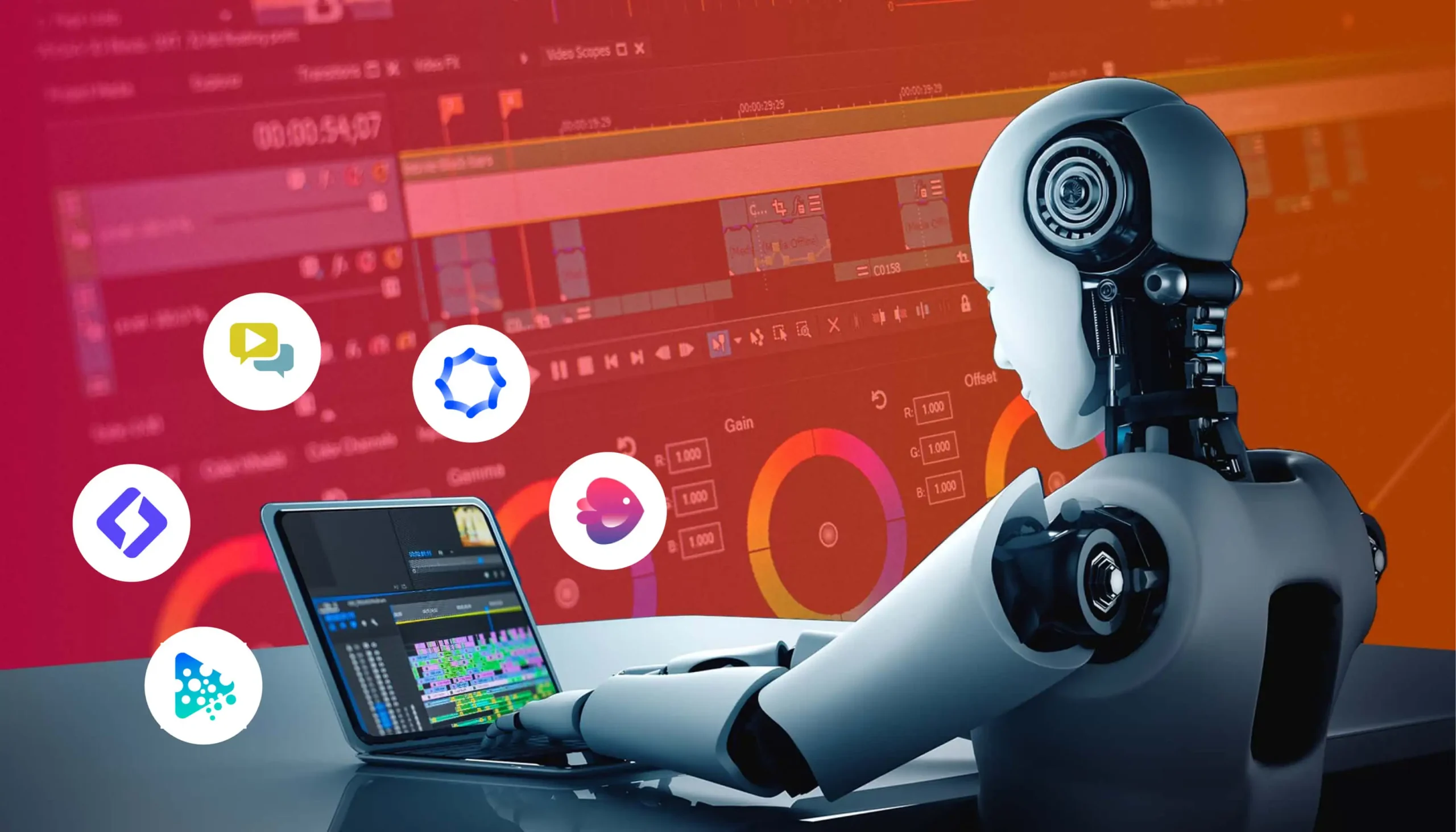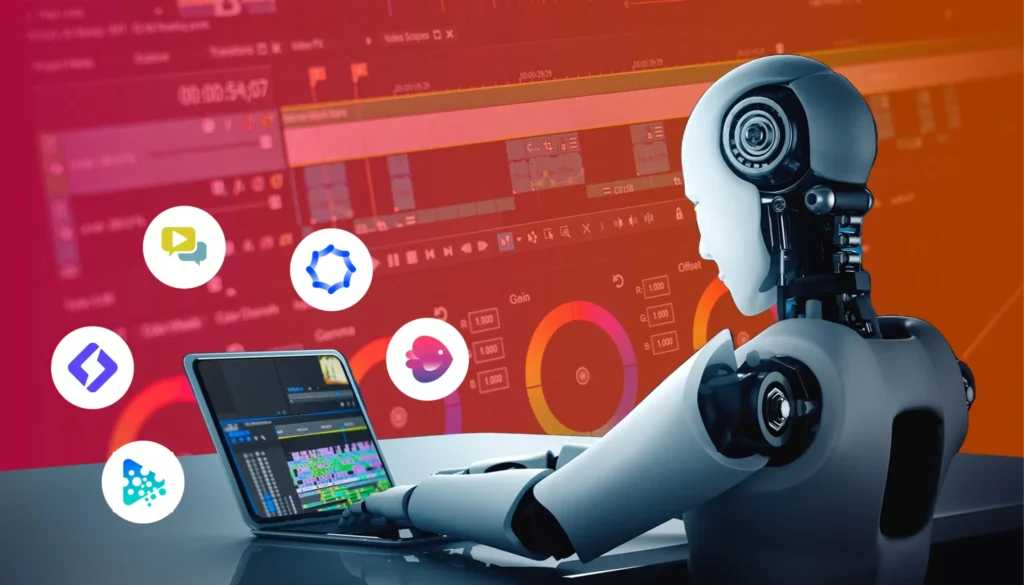AI editors are growing at an alarming rate, but what is the most effective AI editing tool for video? The majority of these tools accomplish the same tasks (removing silence, adding automatically generated captions, cleaning your audio, and more) and are well-liked by those working under strict deadlines.
What about AI-powered tools that effectively edit and contribute to the video editing workflow?
In this article, we’ll look at a few of the new AI toolkits for video editing, which promise to speed up editing in revolutionary new ways. Think prompt-to-edit, or your own personal assistant editor. These tools can be combined into an AI video maker or other tools that automate video creation.
Table of Contents
Why should you look for the best AI video editor?
It’s important to keep in mind that the video tools mentioned are all currently being developed, and at the speed AI is growing, the features and capabilities discussed here may be completely different just a few months from the present.
If the outcomes live up to expectations, the use of the AI-engineered video editor that can assist in the creation of videos offers a number of advantages.
- Speed: Start faster, finish the rough cut faster, and complete your project more quickly.
- Performance: AI tools can handle repetitive tasks with greater efficiency than humans.
- Focused effort: All that time you save on preparation could provide you with more time to work on your project.
- Cycles of iteration: Test fresh ideas faster and more efficiently using the aid of AI.
- Experimentation: You can set three or two agents or AI editors in motion and then see which one produces the most intriguing cutting version.
Are there any valid reasons you shouldn’t use an AI video editing tool to edit video? Absolutely:
- A majority of the tools listed are still in beta, and they aren’t production-ready yet.
- A lot of them require new methods of working and the need for a steep learning curve.
- The most effective way to grow as an editor is to edit the content, but it’s much harder to improve your talents, tastes, and expertise in the absence of actually working on the project.
- It’s not easy to be sure among these AI tools that have actually picked the best ones without checking them yourself.
However, just like the top AI video makers that are available, these tools are on the horizon and could be extremely beneficial if you’re creating an upcoming feature film or for the YouTube channel you run. You should certainly use these devices. Here’s a detailed analysis on five games that are the most loved.
1. Eddie AI
What it can do: Eddie is your new assistant editor. It can record video with metadata and descriptions, edit the footage, and create rough cuts of interviews with multiple cameras, review sources, and create an edit using the story’s framework, according to your requirements. Simply put: Eddie can do it everything.
The reason it’s great. After a brief test, it took around 15 minutes for it to “import” (presumably the transcoding process and transcription) 3 hours’ worth of interview materials onto an M4 2025 Max MacBook Pro. The summary of the text Eddie created was thorough and precise.
The first time user experience was extremely effortless. The UI will show users what to do with the application step-by-step. It also generates the initial edit within 20 minutes of playing around. The app created each of the four-part story framework (intro and conflict, then resolution, and the conclusion) in stages, which means I could go through and revise each one independently.
The whole thing went pretty good. I was awestruck.
What’s still beta: This rough draft is very rough in every sense, and certain edits were quite awkward (because there’s only the transcript). However, it did a decent job at creating something that was somewhat coherent and mostly enjoyable to see.
The issue was that the segments they chose were logical in their own right; however, they didn’t speak to one another, and this caused the story’s flow to be quite complicated.
What you can do to test it: Although the features of Eddi, which were initially all accessible online, are still available for try, Eddi is now mostly an application for desktops that runs on the two platforms of Mac as well as Windows. Download the app and sign in using Google account authentication to begin.
Prices: The Free version lets you edit and view edits made from interviews. It also allows two exports of your project as MP4s (with “light branding”) each month. The Plus subscription costs $25 per month with four projects, plus additional features.
The final thought: What Eddie and his team are building seems like the natural conclusion of how AI prompting comes into contact with editing video. It will only become more efficient.
Being a professional editor, I’m not sure AI editors (at most in the short-term) can overcome the inherent responsibility imposed on editors by humans: watch all the footage, identify the best parts, design some sort of argument, and convince the client to believe that these are the most valuable pieces.
The tools that Eddie has developed, such as automated logging and editing with multiple cameras, should allow editors to begin their work faster and give them more time for polishing the final product.
2. Descriptive of the Underlord
Its purpose: The Descript Underlord was originally an AI-powered feature set that you could turn on at the touch of two or three buttons. It could eliminate silences, tidy up your audio, create AI avatars, and perform more than 20 additional tasks.
Today, it has transformed into an agentic editor that you can use in order to “vibe modify” and edit your video to create a final video.
It’s beneficial because Underlord can access transcripts of your videos as well as audio files; they will be able to listen to and see the source footage as well as your final edit. This will increase the quality of the outcomes.
What’s most helpful is the fact that UI gives a lot of information regarding what Underlord’s doing or thinking about to allow you to track its strategies and their execution.
I uploaded a 40-minute interview, and asked it to produce five minutes of a summary that includes its own narrative arc that goes from conflicts to resolution. It mostly did the trick. However, the edits were rough, particularly when I omitted those words that were filler, and requested Underlord to make edits for clarity.
Despite all the wrinkles, it’s still incredibly impressive, and it’s clear the direction these tools can take in a very short time.
What’s still in beta: Underlord’s capabilities have been task-based for some time, and they’re available with the press of an icon; however, the agentic chatbot interface is in the beta stage. But it can also suggest things that aren’t always correct.
To test it out, visit Descript.com and take a spin. As of the time of writing, it’s completely free to use.
Prices: Standard Descript has a trial for free trial that allows you to test their AI tools. However, should you wish to perform any serious work using the browser-based application, you’ll require a paid subscription that starts at $16 per month.
Last thought: Considering that Descript is based on an existing software that has a wide range of editing tools for video using text, as well as helpful AI-powered fixes (such as eye contact or ADR), it seems like they’re getting an early start in creating an agentic video editor that could provide useful results. It’s also very adaptable, which allows you to use the tools that are built-in to edit or the agent if you decide to.
3. Electric Sheep
Its capabilities: Electric Sheep combines generative AI video as well as agentic editing (prompt for editing), as well as AI-powered tools for VFX (such as automatic rotoscoping and in-painting) to create a single platform.
What’s so great about it: Although it’s apparent that all that Electric Sheep has to offer is beneficial but it’s not a system that you can download and use immediately (which is good). As the above sizzle video demonstrates, there’s a steep learning curve for working with AI that is generative AI. AI video, which includes repairing mistakes, regenerating clips repeatedly, and gaining a better understanding of the mechanics of prompting effectively.
These abilities could be regarded as editing-related, and you could have an idea of how to proceed, but you’ll have to take on a learning curve when using platforms such as this.
What’s still in beta What is still beta? Media uploads are restricted to HD H.264 MP4 or .mov files of 15 minutes or less.
You can try it out: Electric Sheep has a free trial with 150 AI credits to use.
Price: Electric Sheep currently costs $5/month for use. In addition, you have to pay to use AI partner credits in addition to the cost. For instance, creating a video of five seconds required 100 Veo credits.
The final thought is that the name is a reference to the Philip K. Dick novel “Do Androids Dream of Electric Sheep?”, which became Blade Runner. However, it’s not an appealing name.
A majority functions I tested briefly worked, or at least just a bit, whereas others did not work at even. For instance, I commanded the chatbot to insert text into the clip, and it claimed to have done however, I could not find any of the features. It’s still very naive, and I think I’ll take it slow!
4. Spingle AI
What it can do: Spingle is slowly opening from closed beta right now. However, it has promised some intriguing features I’ve never experienced on other AI video editing tools.
What makes it special: Uniquely, Spingle suggests that it can improve the quality of the raw footage you have by cutting out anything that’s too shaky or overexposed. It can also remove anything that is blurred or otherwise not usable. This is done by uploading all your footage into the cloud (an hour of footage would require about an hour to prepare for Spingle to prepare). However, the user interface is within Adobe Premiere Pro, so the majority of users will feel at ease. The DaVinci Resolve plugin will be available in the near future.
Tips: Use proxy servers and an internet connection with high speed to speed up the initial process. It is also possible to leave it running overnight in case you have to process a large amount of footage (but it is still recommended to utilize proxy servers).
Based on my own tests, Spingle took around 20 minutes to eat approximately 30 minutes of documentary footage raw; however, it took only 30 seconds to clean that footage, taking out the blurry, shaky, or inaccessible footage. It was quite amazing to see, and the results were excellent.
I also tried the search feature, which allows it to search for all the usable footage from b-roll of one specific thing within these raw rushes. It also performed this task efficiently. Since the analysis data is stored locally, everything happens within a matter of seconds.
A new feature in the pipeline promises to allow you to “train Spingle on past projects to build your own AI templates that can be used in any style you like.” This clearly will benefit you if an experienced editor and would like to emulate a certain client’s style; however, it may also let you rip off the style of a different editor.
(Which is how you are taught to edit initially. However, now it will be automated, and you’ll have learned nothing.)
What’s still in beta? Everything. However, you can stay updated with the latest features rolling out to beta users every week by visiting this page.
How to test it: Fill out the early access form, and download the most recent version.
Pricing: Undisclosed.
Last thought: One thing I like most about Spingle is it was created for video editors by editors of video. For instance, when it auto-makes selections based on the prompt you provide, it does this by lifting these onto track 2. This is the way I make my current selections.
The current version is impressive and provides an AI assistant that will assist you in speeding up the process of editing. Whatever they create appears it will be a good fit for the existing editorial workflow,s which is a real win for human editors.
5. AutoPod
What Autopod does: It is a suite of software specifically designed for video podcasters as well as Multi-camera interviews. It cuts automatically between camera and social media videos and eliminates silence from certain sections of the footage you’re using as a source.
The reason it’s great: Autopod will help you save the time of waiting for the first cut of interviews with a variety of cameras. This is an enormous benefit because most of the time, this method involves cutting directly to the person who is speaking, and possibly concealing an edit by using the cutaway of another person smiling in agreement. It’s pretty boring work.
Video podcasts are among the most popular media formats in the present, particularly since more and more YouTube viewers are turning to longer videos (20 minutes or more) on their TVs. As a result, the demand for this type of editing will only rise.
Autopod is only compatible with Adobe Premiere Pro; however, it needs individual audio tracks for each speaker to decide who to cut. It’s likely that you already have them; however, if you’re planning on cutting between the cameras of one speaker, you won’t.
What you can do: Try it for free at Autopod.fm.
Pricing: Autopod costs $29 per month; however, you receive the first month for free.
Last thought: This type of auto-editing function has been implemented to DaVinci Resolve 20 as well, and for sure it will be available in the near future. Adobe Premiere Pro natively.
However, Autopod is (AFAIK) the OG of this method. This is an AI that could aid editors in getting their jobs done more efficiently and also produce satisfactory results that customers might be willing to accept, and consequently, let us out of the field.
The Most Effective AI Video Editor and MASV Let’s Get Automated
Which is the top AI editing software for video?
- Of all the tools on the list below, AutoPod seemed the most reliable. It’s because you can clearly see the process and make adjustments to every aspect of the work. All the cuts are within the timeline.
- Eddie AI is developing what appear to be some very useful features, like auto recording and stringouts; however, I’m not sure I’d be able to trust it with raw cuts from interviews right now.
- Spingle AI is also impressive as an assistant AI that could improve your workflow for editing.
Although these tools seem to be a bit naive at the moment, it’s clear that this, perhaps coupled with the use of an AI video generator that can create videos, is the future of editing video. It all comes down to your expectations: Know the capabilities of these tools and what they don’t, and what you’re most comfortable trusting them with.
My suggestion for a film editor: Try to determine if delegating tasks to an AI editor can benefit the workflow (such as audio cleanup), as well as where it may affect your work on your ability to create the most effective version of your film.
While you’re there, why not combine MASV’s quick file transfer speed with your preferred AI video editing software? It’s possible to connect MASV with your preferred cloud storage service to automate the transfer of files with no code needed. Since automations aren’t only for AI platforms, they’re for everyone.





























